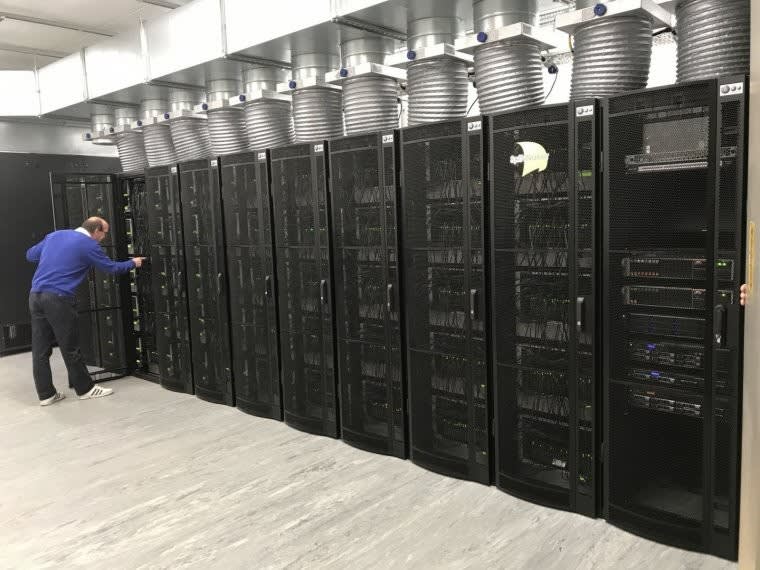Replicating the Human Brain with the SpiNNaker Neuromorphic Computer
Follow articleHow do you feel about this article? Help us to provide better content for you.
Thank you! Your feedback has been received.
There was a problem submitting your feedback, please try again later.
What do you think of this article?
Neuromorphic computing, a concept developed by the American Scientist Carver Mead which describes the VLSI of analogue and digital circuits to mimic neuro-biological architecture has gained a few extra IQ points this year. The Spiking Neural Network Architecture, or if you can’t remember that mouthful, The SpiNNaker Machine was recently fired up for the first time complete with its one millionth processor core.
The SpiNNaker Neuromorphic Computer
20 Years in the Making
Over 10 years in the making and close to 20 years since its conception the SpiNNaker Machine is the ‘brain-child’ if you excuse the pun, of The University of Manchester’s School of Computing Science program and Professor Steve Furber, who originally conceived the idea. This landmark neuromorphic computer is capable of modelling more biological neurons in real-time than any other machine currently in existence, at least one that we know about that is!
As you can imagine this unique machine’s build and design process hasn’t been cheap, with over £15 million in funding in the past 20 years from the EPSRC (Engineering and Physical Sciences Research Council) and more recently by the HBP (Human Brain Project) that helped with its design and conception.
Biological Neurons
A biological neuron sometimes referred to as a spiking neuron is a form of brain cell that resides in the nervous system that communicates by emitting spikes of electrochemical energy across their cell membrane. The SpiNNaker machine is unique when it comes to computation functionality, instead of sending data from point A to point B within a regular network it sends billions of small packets of data simultaneously to many thousands of differing destinations. The SpiNNaker is the most capable Neuromorphic Computer developed so far that has been specifically designed to mimic the parallel communication architecture of the human brain. Essentially it’s a computer that functions more like the human brain than your regular traditional idea of a computer ever could.
The creators of this unique concept haven’t finished yet, their goal is to keep on expanding on this until they can model a billion biological neurons in real-time. It all might seem a long way off at the moment, but this landmark neuro-computer is an important step closer to that goal. To gain some perspective regarding the scale of the task at hand the brain of a mouse consists of around 100 million neurons, whereas the brain of the average human being is said to consist of around 100 billion neurons (I don’t think anyone has counted them all yet!). All of these neurons are, in turn, all interconnected with around 1 quadrillion synapses, an almost incomprehensible figure to imagine.
What can you actually do with it?
What use is a computer with one million processing cores that can mimic the way the human brain functions be actually useful for? One of the primary reasons behind the development of this neuromorphic computer is to help Neuroscientists understand how the brain functions, and does so by running extremely massive and complex real-time simulations. Recently, for example, the SpiNNaker, when it had only 500k processors, was used to simulate the real-time processing of a series of isolated brain networks, including the eighty thousand neuron model of a portion of the human cortex. The cortex, found on the surface of the brain is ultimately responsible for receiving and processing information from the various senses. This rather clever computer is also demonstrating its abilities in the fight against the dreadful illness Parkinson’s disease by simulating a region of the brain called the Basal Ganglia where the illness is known to affect. What is certain is that this device does appear to hold great potential for exploring neurological functionality and disorders of that ilk, which could lead to a greater scientific understanding and the potential treatment of certain ailments.
The SpiNNaker chip
One Million Cores? So What!
There may be other computers out there that feature as many processors, or perhaps many more than the SpiNNaker, but what makes this computer different is the infrastructure that connects all of the processors together. The human brain can fire billions of neurons and transmit signals simultaneously to thousands of different destinations, this super neuromorphic computers architecture supports a staggeringly high level of processor-to-processor communication, much like the human brain, which other computers simply lack. The SpiNNaker is apparently capable of processing 200 quadrillion actions simultaneously which is a seriously impressive figure indeed.
The Brain Mimic
What the comparison between the functionality and ability of the SpiNNaker compared to a real human brain? There is still a long way to go before it comes close, even with its staggering specification the SpiNNaker still has around only 1% of the abilities of your average human brain and that’s probably pushing the estimation of its current abilities. Currently, and as far as we know, mimicking a human brain is beyond the scope of science and technology. As some of you may have noticed, this machine is not too dissimilar in scale to the early room-sized computers from a few decades ago that by today’s standards could barely compete with a pocket calculator. Technology has a habit of making rapid surges and it may just be a matter of sooner rather than later until a neuromorphic computer can fit in the palm of your hand. Time will tell.




